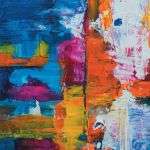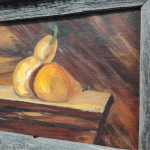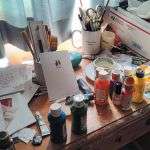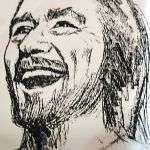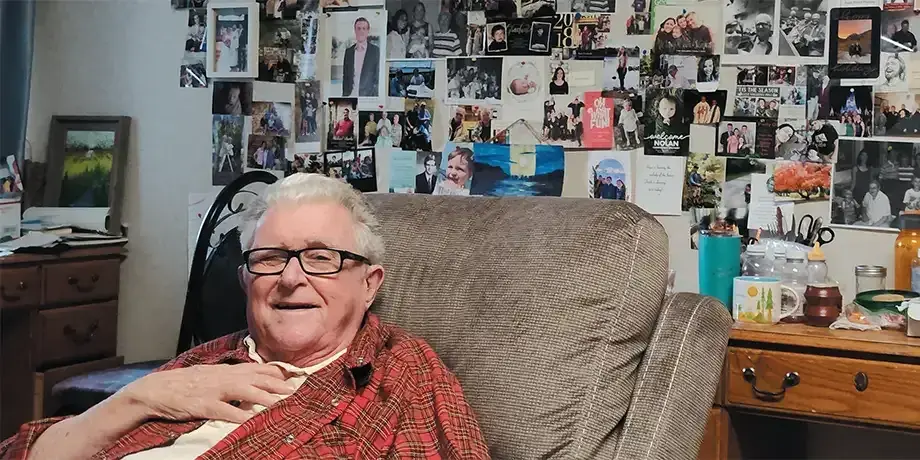
Columban Fr. Bill Brunner keeps his eyes open for seashells, which are plentiful in the Ocean State, Rhode Island, where he lives. The Columban Fathers have their own community of retired priests in Bristol, on the shores of Narragansett Bay, but Fr. Bill finds shells when walking the beach or visiting the local state park on a Saturday afternoon outing with the other missionary priests he lives with. He also finds them right at the dinner table.
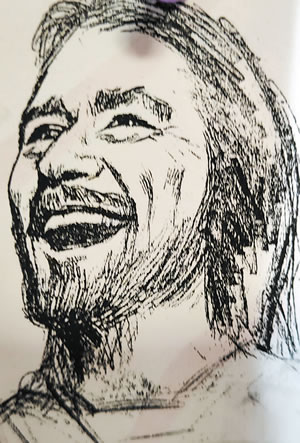
We often have fresh shellfish delivered to St. Columban’s Residence, as well, either from a local seafood delivery company or straight from our cook, who often serves up what he raked out of the mud at low tide earlier in the day. Then Fr. Bill puts six or seven shells into his pockets at the end of a meal, and washes them out, after a feed on the little necks, quahogs and clam chowder for lunch. After they dry, he paints designs and scenes on them.
Fr. Bill has been enthusiastic about the “spirituality of color” from an early age. His older brother Dick, when they were growing up together in Iowa, first alerted him to how faith and art come together in unexpected ways. His brother sometimes pointed out to him that the figure of Christ in Catholic schools was a sad figure, suffering on the cross and close to death.
“Why can’t they make a joyful Christ?,” he wondered to his brother. The question stuck with him, and over Fr. Bill’s years serving abroad in the Philippines, and Alaska, and later on in New Mexico, he looked for and promoted the search for new images of Christ.
While in New Mexico, he met Fr. Thomas Keating, a Trappist monk based in Colorado, who was known for his work in developing and promoting Centering Prayer, a Christian form of meditation, and his exploration of interreligious dialogue and the mystical path, emphasizing interconnectedness and the importance of transcending limitations.
This contact led Fr. Bill to explore whether a new image of Christ could be created that would catch Christ in another mood, apart from the despair of the Cross—after playing with children, for instance, or when enjoying the company of His disciples, or while sharing His teachings on how God reveals to the merest children what highly educated people and revered sages miss out on.
His conversations with Franciscan sisters who were traveling through his pastoral area in New Mexico, where he worked with Apache Native Americans, led them to return the following year with a gift, brought back from California: a drawing of The Laughing Christ. Fr. Bill was delighted with it, and had many prayer-card copies made of the image, and still hands them out to visitors today—some 40 years later.
While in New Mexico, he also met Robert Lintz, who painted The Apache Christ for his parish and set it up behind the main altar of the church where Fr. Bill worked. It also showed a novel image of Our Lord, with the features and dress of an Apache young man. The local Apache community responded warmly to this culturally more accessible image.
Some of Fr. Bill’s own paintings adorn the walls of St. Columban’s Residence, and his love for color shines forth beautifully in these works, as well as from the seashells he paints from time to time, and gives away to visitors. The creative flow keeps pouring out of Fr. Bill in the visual arts, as he continues to nourish his own life with the practice of painting shells with oils and acrylics.
Fr. Bill impresses all of us here with what God continues to create through him, reminding the rest of us of our own opportunities for presenting to the world a smiling, colorful faith that comforts, inspires and creates bonds in an otherwise divided and dark world. Thus, he continues his mission, to announce the Good News of God’s love and life to others.
Columban Father Robert Mosher is the House Leader of St. Columban’s Residence in Bristol, Rhode Island.
